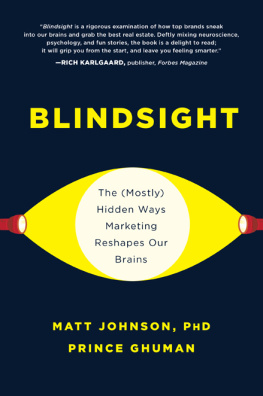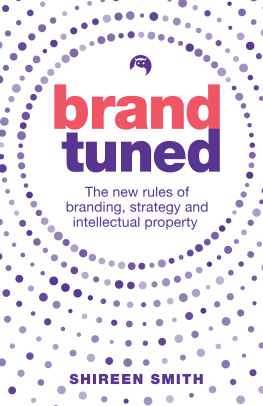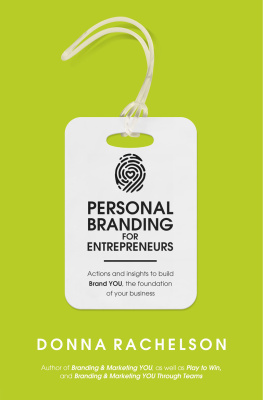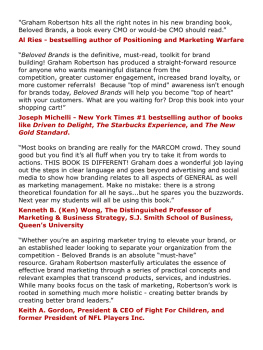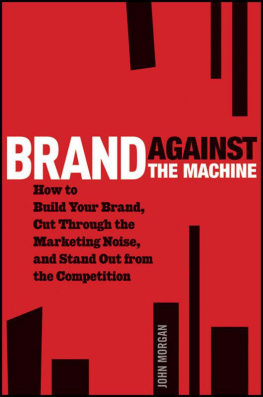
i
Praise for Branding that Means Business
By bridging the gap between brain science and business effects, Johnson and Misiaszek have produced the most insightful book on branding of the last twenty years.
Rory Sutherland, Vice Chairman of Ogilvy and author of Alchemy: The Dark Art and Curious Science of Creating Magic in Brands, Business, and Life
Brimming with insight The business landscape has never been busier, but Johnson and Misiaszek wisely and entertainingly explain how to rise above the crowd.
Adam Alter, Professor of Marketing and Psychology, NYU Stern School of Business and New York Times bestselling author of Irresistible and Drunk Tank Pink
A wonderful blend of academic insights and practical know-how.
Richard Shotton, author of The Choice Factory: 25 Behavioural Biases that Influence what We Buy
Applying a social neuroscience lens to branding, Johnson and Misiaszek offer practical steps for harnessing the fundamentals of human nature to build compelling and enduring brands that deeply connect with customers an extremely engaging, no-nonsense, and accessible book that could not be more relevant in our ever-changing world of work a must-read!
Jacinta M. Jimnez, psychologist, VP of Coach Innovation at BetterUp and award-winning author of The Burnout Fix
ii Perhaps the most important and hardest problem any business faces is how to create a successful brand that deeply resonates with consumers This brilliant book clearly and engagingly explains the role brands play in the life of todays consumers, and how to create brands that successfully change the minds and behaviour of consumers for good.
Richard Chattaway, CEO of BVA Nudge Unit UK and author of The Behaviour Business
This book goes beyond the buzzwords and hype surrounding marketing and brand success. Johnson and Misiaszek offer cogent advice on what practical steps should be taken to enhance the value that firms create for their stakeholders. This is an important and highly accessible book, filled with great examples for marketers to learn from and apply.
Philip Sugai, Professor of Marketing at Doshisha Business School and author of The Value Plan
The digital economy is also the fragmented economy: which influencers or AI-enabled bots can customers rely on? Johnson and Misiaszek brilliantly demonstrate how purpose-driven brands can inspire and guide people, businesses and ultimately societies.
Jean-Marc Laouchez, President of the Korn Ferry Institute
The authors bring a fresh, multidisciplinary approach to understanding why brands matter to and create value for consumers. This book offers focused advice for building and shepherding brands that symbolically deliver meaning to address the socio-cultural needs of contemporary consumers.
Jill Avery, Senior Lecturer of Business Administration and C. Roland Christensen Distinguished Management Educator, Harvard Business School
v
Matt: For Marlene, Santi and Diego
Tessa: For Braden and Max
Contents
At the time of his arrest, hed lived a life few could dream of. He graced the covers of magazines, married supermodels and chummed with world leaders. Aged 40, he became the youngest vice-president of General Motors. His DeLorean sportscar was cemented as a cultural icon when it appeared in Back to the Future.
But a career fuelled by a grand vision for the future ultimately crashed and burned, punctuated with an arrest for smuggling $27m of cocaine. Legal fees and lawsuits ultimately bankrupted him and his company.
John DeLoreans insatiable fervour for the future produced the highest of highs and lowest of lows. On the one hand, his story is a Greek tragedy: a classic cautionary tale of flying too close to the sun. Few business leaders even those who, like DeLorean, consider themselves visionary leaders aspire to such volatility.
But on the other hand, theres an element of DeLorean that is central to every business: trying to understand, predict and shape the future.
Firms and business leaders go about this in a variety of ways. Companies rich in data create algorithmic simulations of how future scenarios play out. Futurists employ complex trend analysis to project years and decades ahead. Some, like Sony co-founder Akio Morita and famed designer Diane von Furstenberg, use the services of fortune tellers. John DeLorean himself regularly consulted a psychic.
With all the obsession with the future, its worth exploring another perspective that may be even more powerful than prediction. Instead of trying to predict what will shift, its worth asking what is most likely to remain. Over time, and especially in times of intense transformation, what stays the same?
Jeff Bezos is fond of this perspective. He once remarked, People are always asking me, whats going to change in the next 10 years? But a much more powerful question is whats not going to change? For Bezos, his bet was that, whatever future may come, consumers will always value convenience. Its impossible to imagine a customer saying, I love Amazon but I wished they delivered slower. Its a bet on which his brand strategy was built, and which, in hindsight, was spot on.
Capitalising on enduring elements of consumer demand can be a powerful strategy. Bezos made the bet that efficiency was going to be a constant. Nike has bet that people will always want to strive to be greater than themselves; Spotify believes that, with the right platform, people will want to stream music more than theyll want to steal it.
That brands often find success orienting their strategy around a constant truism of human nature points to a greater point about branding: much success can be found by harnessing the fundamentals of human nature. The precise character of the future is unknowable. Technology will change, geopolitics will shift and commerce will grow in new, unforeseen ways. But whatever the future holds, humans will still be humans. That is what this book is about: branding fundamentals built on the fundamentals of human nature.
Make no mistake, this is a business book. But as well see, the branding world finds itself at a crossroads, and it cant afford to get by simply with the fundamentals of its own industry. In constructing this guide, we draw not only from the business literature but also from the social sciences: psychology, sociology and even anthropology. While the brand has a business purpose, the mechanisms that enable it to be a business asset are about connecting with human beings.
This approach is not only advantageous, its crucial. Mediocre branding is quickly becoming a thing of the past. If the brand isnt excellent, it may as well not exist. In order to understand this, we need to unpack how, specifically, brands mean business. And how, in the current era, the bar has been raised.
What does it mean for branding to mean business?
Clearly, a strong brand can be a tremendous asset to a company. Often, its the most important asset. But when does a brand have this kind of influence? How does a brand mean business?
Brands matter when, and only when, they matter to consumers. Theyre an asset to a company when, and only when, they hold meaning and carry significance within minds and lives. This is how brands mean business.
But as well see in more detail throughout this book, the threshold for endearment has never been higher. We find ourselves in a fast-paced world of immediate gratification where consumers can, with the touch of a few buttons, listen to any song, watch any movie or read any article. Consumers are peppered with hyper-personalised targeting for products that can be ordered seamlessly and arrive within hours. All this value can be delivered to the consumer in the absence of a known, trusted brand.


